Personal injury protection (PIP), which is also called “no-fault insurance,” covers medical bills and related costs resulting from an accident, no matter who caused it. It is a component of an automobile insurance plan that covers the healthcare expenses associated with a car accident.
PIP covers medical expenses for both injured policyholders and passengers, even if some don’t have health insurance. It is required in some states as part of “no-fault auto insurance” laws that restrict your ability to sue for car crash injuries. If PIP is optional coverage in your state, it can still be a valuable part of a car insurance policy.
It may overlap with your health or MedPay insurance, but there are times when multiple policies are recommended.
Understanding PIP insurance
Personal injury protection, also known as “no-fault insurance,” pays the medical bills and rehabilitative costs for you and your passengers after you’re injured in a car accident. PIP also extends to instances when you’re a passenger in someone else’s car, or if you’re hit by a car while a pedestrian or cyclist.
PIP insurance is different than bodily injury liability insurance in that, while PIP coverage pays for your own expenses, liability insurance pays for the medical expenses of drivers and passengers in other cars when you are at fault for an accident.
This insurance may include some of the same coverage as your health insurance or Medical Payments policy. However, PIP coverage is specifically written for car-related injuries, which are sometimes excluded from health insurance policies, and PIP insurance covers a number of additional expenses not covered by MedPay insurance.
Auto insurance requirements and features differ from state to state, and PIP coverage is available primarily in no-fault states. In a no-fault state, if a policyholder is injured in a car crash, that person’s policy pays for the holder’s medical care regardless of who caused the accident.
Policyholders with PIP coverage can receive benefits even if the other driver doesn’t have insurance.
Minimum PIP requirements by state
PIP insurance is sometimes called “no-fault insurance,” since a minimum amount of PIP coverage is required if you live in a no-fault state. In these states, your own insurance policy will cover your expenses — even if another driver caused the accident — unless a certain threshold is met.
These thresholds, called “tort thresholds,” may be either monetary or verbal, depending on your state.
Monetary thresholds require medical expenses for an individual or accident to exceed a state-designated amount before you can sue another driver. Verbal thresholds specify a certain type of injury that must be met before you file a lawsuit. Although the language varies by state, verbal thresholds typically say an individual must have sustained significant and permanent loss of bodily function, injury or disfigurement, or death.
Other variables, such as if a driver was under the influence of drugs or alcohol, can also change how tort thresholds are applied.
In addition to the 12 no-fault states, four fault-based states also require PIP coverage. Other states allow you to purchase it as optional coverage.
What does it cover?
PIP insurance generally covers:
- Your medical expenses from a car accident.
- Your wages lost due to the injuries.
- Rehabilitation costs.
- Replacement services for things you can’t do for yourself or your family, because of the accident, such as house cleaning and child care.
- Funeral expenses and survivor benefits.
- Some home care expenses, such as childcare or house cleaning, if you’re unable to fulfill these duties yourself
A goal of PIP is to provide prompt payment for car accident injuries. Because PIP claims are paid regardless of who caused the accident, there’s no waiting around for a liability lawsuit against someone else to be resolved.
PIP insurance does not cover:
- Bodily injuries to the other driver and their passengers.
- Injuries in an accident if you are driving for work purposes.
- Injuries from an accident while you were committing a crime.
- Damage to someone else’s property.
- Damage to your vehicle.
How does PIP work with other types of insurance?
If you’re injured by another driver and have personal injury protection as part of your car insurance policy, you would typically exhaust your PIP coverage first before turning to other options. If your medical costs exceed your policy’s limits, you can then file a claim under the other driver’s liability insurance policy.
However, if you are significantly and permanently injured, or if your medical bills exceed your state’s tort threshold, you may bypass your PIP coverage and file a lawsuit against the other driver.
Personal Injury Protection (PIP) vs. Liability Insurance
Personal injury protection is not the same as liability insurance.
With PIP, medical costs are covered for the policyholders and anyone in their vehicle at the time of the incident, no matter who is at fault. However, with liability insurance, medical costs are covered for the third party, not the policyholder, if it is determined that the policyholder is at fault.
| Personal Injury Protection (PIP) | Liability Insurance |
| Covers the medical expenses from an accident for anyone in the policyholder’s vehicle no matter who is at fault | Covers medical expenses of a third party if the policyholder is at fault |
| Required in 16 states | Required in all states |
| Does not cover property damage | Covers property damage to a third party’s property if the policyholder is at fault; does not cover damage to your property |
Liability insurance pays for injuries caused to another party, such as a pedestrian or the driver and occupants of another vehicle. It does not cover your own medical expenses if you caused the accident. It is also required by every state.
PIP, which is only required in 16 states, is not a substitute for liability insurance.
There’s also professional liability insurance (PLI). Such policies are generally taken out by financial advisors, business owners, landlords, doctors, lawyers—anyone at risk of being sued for damages and/or injuries.
Personal Injury Protection vs. Medical Payments Coverage
Personal injury protection insurance and MedPay are pretty similar, which is why policyholders can’t purchase both types of insurance on the same policy.
Below, we’ll run through a few differences between PIP insurance and MedPay:
- States available. No-fault states require that drivers hold PIP, while certain at-fault states have it as an option. MedPay is unavailable in places that follow no-fault laws.
- Deductible amount. Those with MedPay have no deductibles when the coverage applies to their medical treatments. Drivers with PIP insurance typically have deductibles, and they may also deal with their health insurance deductibles.
- Extent of coverage. PIP insurance is more comprehensive than MedPay, as it extends beyond medical care to include childcare expenses and lost wages.
In certain states, drivers get to choose between PIP insurance and MedPay. Carefully consider which type of medical coverage you’d prefer on your car insurance policy before selecting one, as each of these options has its pros and cons.
Cost of PIP insurance
PIP is relatively cheap insurance considering the benefit it can provide. Expect to spend anywhere from $5 to $50 per month for the coverage limits it offers.
No-fault coverage is typically more expensive than what’s found in states with at-fault insurance laws. And while personal injury protection coverage in no-fault insurance states is often associated with higher rates, this isn’t always the case.
In the event of a serious car crash, the costs of medical services that PIP covers will often amount to significantly more than the total spent on the coverage to date. The policy’s limits will allow you to afford medical care that may not be covered by liability insurance, which is why many states require PIP insurance.
If you live in an at-fault state and can afford to cover medical expenses without making a PIP claim, you may want to skip coverage. However, the generous PIP limits and the typically low costs for coverage make it an enticing option for all eligible drivers.
How to file a PIP claim
You submit a claim like any other type of insurance, either online or through the phone. PIP will help pay for medical expenses necessary immediately after the accident. But for ongoing, non-urgent claims, you’ll be required to review or pre-approve your treatment plan with a medical expert of your insurer’s choosing or an outsourced medical claims processor.
Your auto insurance provider can also approve partial reimbursements or even have you examined by a medical provider of their choice. The amount your policy covers may vary depending on your plan and on your state.
It’s critical to follow your auto insurance company’s process and timeline. In New Jersey, for example, any medical care or treatment within the first ten days after the accident must be approved and certified by your insurer. Failure to provide the required “Attending Provider Treatment Plan” and its documentation can result in a co-payment penalty of as much as 50%, regardless of whether the procedure or diagnostic test was medically necessary or reasonably required.
In New York, all medical bills should be submitted within 45 days of treatment to be considered for payment; otherwise, written explanations must be provided.
Ask your insurance agent for their PIP claim process requirements and keep a copy on hand in case you’re injured.
Do I need Personal Injury Protection (PIP)?
Personal injury protection (PIP) insurance coverage includes payment for injury-related medical and rehabilitation expenses, loss of income, and funeral and burial expenses. Some states require drivers to have PIP. It is optional coverage in other states and not available in others.
In states where PIP is optional, it’s generally a good coverage to have. That’s because PIP can help cover expenses, such as your health insurance deductible, lost wages and replacement services for tasks you cannot perform due to your injuries, such as child care or house cleaning.
Is PIP the same as bodily injury?
Personal injury protection (PIP) is designed to cover medical costs related to an accident, no matter who is at fault. Bodily injury liability coverage, on the other hand, provides coverage for medical expenses related to someone who is injured when you are at fault.
Should I get Medical Payments Insurance on top of PIP?
Both PIP and MedPay insurance are meant to cover medical bills after an auto accident. However, MedPay doesn’t cover many of the additional expenses that PIP covers, including lost wages, rehabilitation services or childcare.
Because of this, if you live in a state that offers PIP coverage, MedPay may be unnecessary. However, if your state has a low limit to how much PIP insurance it requires, a medical payments policy may provide supplemental coverage.
Recommended Articles
- Moving Insurance: Coverage, Cost & Top Providers
- How Much Dwelling Insurance Coverage Do I Need?
- How Much Does Flood Insurance Cost?
- Term and Whole Life Insurance: What’s The Difference?
- Best Esthetician Insurance For Business
- Car Totaled Insurance: All You Need To Know






